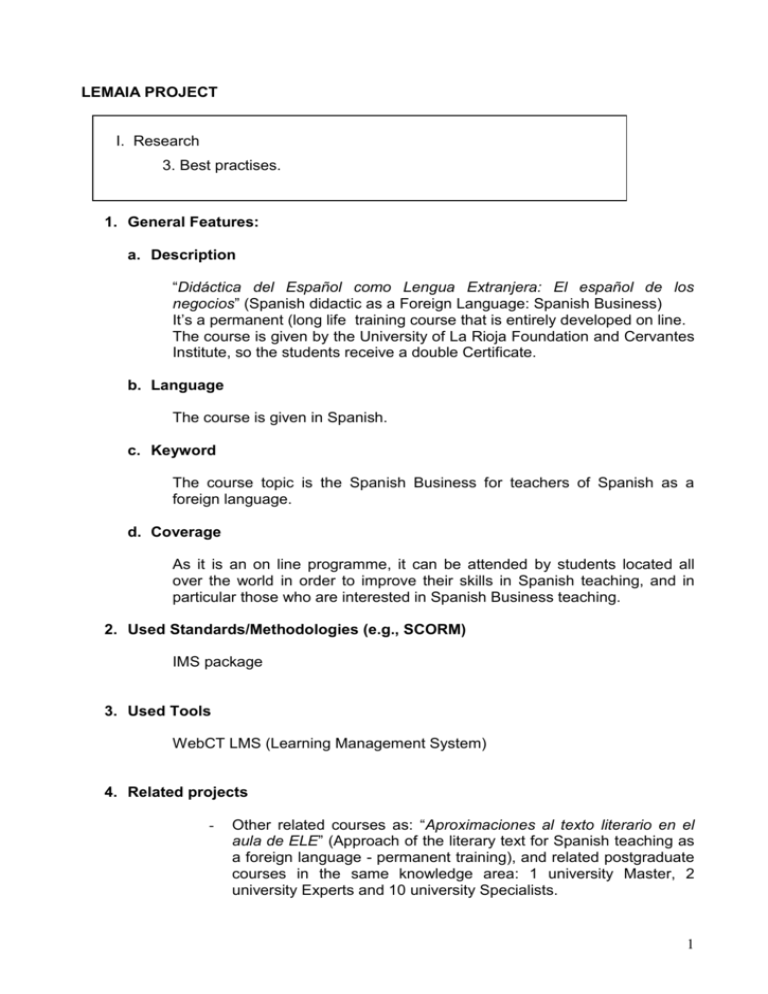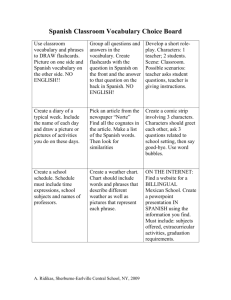Fundación de la Universidad de La Rioja
advertisement

LEMAIA PROJECT I. Research 3. Best practises. 1. General Features: a. Description “Didáctica del Español como Lengua Extranjera: El español de los negocios” (Spanish didactic as a Foreign Language: Spanish Business) It’s a permanent (long life training course that is entirely developed on line. The course is given by the University of La Rioja Foundation and Cervantes Institute, so the students receive a double Certificate. b. Language The course is given in Spanish. c. Keyword The course topic is the Spanish Business for teachers of Spanish as a foreign language. d. Coverage As it is an on line programme, it can be attended by students located all over the world in order to improve their skills in Spanish teaching, and in particular those who are interested in Spanish Business teaching. 2. Used Standards/Methodologies (e.g., SCORM) IMS package 3. Used Tools WebCT LMS (Learning Management System) 4. Related projects - Other related courses as: “Aproximaciones al texto literario en el aula de ELE” (Approach of the literary text for Spanish teaching as a foreign language - permanent training), and related postgraduate courses in the same knowledge area: 1 university Master, 2 university Experts and 10 university Specialists. 1 5. Technical Features a. Format (Technical formats of the learning objects. e.g., video/mpg, text/htm) The students can access to the course contents in the Internet, so that the course architecture is based on Hypertext and HTML, including some PDF files as well as interactive assessments. b. Location (Universal Resource Identifiers) Protocols: HTTP and HTTPS Chat protocol. Proprietary protocol Whiteboard protocol: proprietary protocol Server Public Name: urvirtual.unirioja.es URL: http://www.fundacion.unirioja.es/aula_virtual.shtml http://www.campusvirtual.unirioja.es URN: /SCRIPT/<CourseID>/scripts/serve_home (The student needs to login to validate his access to the course.) c. Requirements The technical requirements are the same ones requested to access the Internet from home. The specific system requirements are accessible by the students in the Campus Virtual Web (http://www.campusvirtual.unirioja.es) and they also can find the minimum requirements in this specific web: http://www.webct.com/tuneup/viewpage?name=tuneup_browser_tuneup_infor mation#browsers 6. Educational Features a. Requested Interactivity Type (active, expositive, mixed) The course is highly interactive, but uses a mixed methodology. The students have to study the theory contents and at the same time they have to participate in a lot of activities during the course, which are previously planned by the on line team of teachers and readjusted while the interaction is happening. b. Learning Resource Types (exercise, simulation, questionnaire, diagram, figure, graph, index, slide, table, narrative text, exam, experiment, problem, statement, self assessment, lecture) The different learning resources that the student can find in the course are: .- reading hypertext contents with summary, bibliographies, internet resources lists,,, .- Interactive glossary ,- Case studies 2 .- Individual and team activities .- Self assessment - Interactive activities In every edition of the courses is possible to find other resources because the teaching team is able to adapt the learning resources in function of the students group. c. Requested Interactivity Level (very low, low, medium, high, very high) The requested interactivity level is very high, and participation activities are included as evaluation requirements of the course. d. Semantic Density (very low, low, medium, high, very high) of the Learning Resources Medium e. Intended End User Role (teacher, author, learner, manager) The following roles appear in every course: - - - - Academic Coordinator. He is a high qualified professional of the area who controls all the teaching-learning process and gives the final mark of the course. Academic on line tutors. Every contents of the course is given by those specialists. They guide the learners in the learning process of the different contents units. Foundation support. He establishes the relation between the organization and the learners and resolves the technical problems that could happen during the courses Students f. Context (school, higher education, training, other) It is a permanent training programme dedicated to university graduates in Hispanic, etc. with a higher education Degree. g. Typical Age Range The students are professionals in the languages teaching area or need to posses a university degree, so it would mean that the students are up to 23 years old. h. Difficulty of the learning resources (very easy, easy, medium, difficult, very difficult) (Medium) 3 The learning resources are defined in different levels, so we adapt them to each group of students once the course begins. 7. Cost (Whether use of the learning objects requires payment.) It is always a fix fee. For this course it is fixed on 395 €. 4







